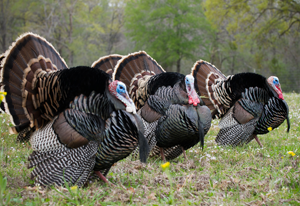 If you want to hunt a turkey that is not heavily pressured and will come to, and respond to, your call very well, then try hunting Merriam’s wild turkeys. The Merriam’s subspecies of wild turkey, named in honor of C. Hart Merriam (not that you’ll care about that as you squeeze the trigger on one) lives primarily in the western mountain regions of the United States. These birds are very pretty with their near stark white tipped tail and lower back feathers and bronze and purple iridescent feathers on their breasts and upper backs. The Merriam’s is comparable in size to the Eastern wild turkey, but Merriam’s typically don’t grow very long spurs or beards because of the terrain and climate they live in.
If you want to hunt a turkey that is not heavily pressured and will come to, and respond to, your call very well, then try hunting Merriam’s wild turkeys. The Merriam’s subspecies of wild turkey, named in honor of C. Hart Merriam (not that you’ll care about that as you squeeze the trigger on one) lives primarily in the western mountain regions of the United States. These birds are very pretty with their near stark white tipped tail and lower back feathers and bronze and purple iridescent feathers on their breasts and upper backs. The Merriam’s is comparable in size to the Eastern wild turkey, but Merriam’s typically don’t grow very long spurs or beards because of the terrain and climate they live in.
The Merriam’s wild turkey is a lot of fun to hunt as these birds will travel for what seems like miles to a call. They will climb up and down mountains and hills and fly across creeks and canyons to find a little loving. My personal opinion (if you want science, there are other websites for that) is that Merriam’s wild turkeys may be the easiest subspecies of turkey to call in. I do attribute that to low hunting pressure from locals, as most of the states Merriam’s inhabit probably have more turkeys than humans (this is a joke, but again, if you want science, there are other websites for that). The Merriam’s population is estimated to be approximately 350,000 birds, and you can find populations of these birds in Colorado, Wyoming, Montana, New Mexico, Arizona, North and South Dakota, Nebraska, California, Washington, and Oregon. The mountainous areas you will hunt Merriam’s in are some of the most beautiful surroundings anywhere, and you can get quite the workout while hunting them. I have found that where you find elk and elk sign, you’ll find Merriam’s wild turkeys. However, if you are looking for a bit of an easier Merriam’s hunt, then try the Black Hills of South Dakota or the northeast corner of Wyoming near Devil’s Tower. You’ll still need to be in shape to maneuver these areas; however, you will not need to verify that your family tree contains a line of mountain goats in it to have a fun, successful hunt. Unlike the Osceola turkey, public land that is open for Merriam’s hunting is very plentiful, and I venture to say that the success rates on those public lands is quite high compared to public land east of the Mississippi River (don’t tell me I have to mention that this ain’t science again).
Here are a few hunting tips for you to keep in mind when pursuing Merriam’s wild turkeys. As far as which calls you should take with you on your Merriam’s hunt, I have found that high pitched box calls will get a good response from lonely Tom’s. The terrain these turkeys inhabit can be a friend or a foe during your turkey hunt. Don’t be afraid to use the hills and mountains to your advantage to get in front of henned-up birds. Also, keep in mind that if a gobbler is walking away over a hilltop convinced that there is no hen where he knew there was a hen, he will look back one more time before disappearing over the ridge. So, when he ducks his head as if he’s gone, he’s usually not, and he’ll poke his head back up for one last look almost every time. Also, you may want to take a range finder on this trip with you and measure the distance to a few unique spots between you and the gobbling bird so you know when a bird enters your effective gun range as the openness of the landscape lends itself to misjudging distances. The last thing you’ll want to do is to miss the only chance you had at filling the Merriam’s portion of your grand slam because you thought a bird was 30 yards away when he was actually 55 yards away.